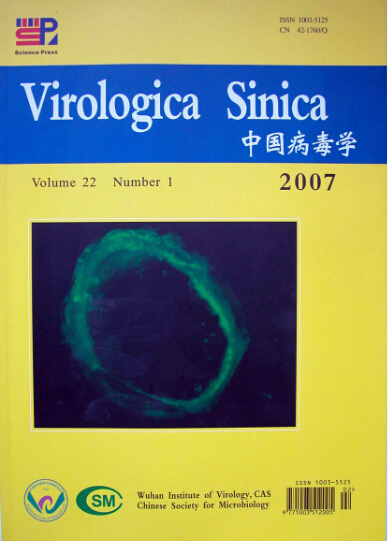-
Huang R,Chen X X,Zhang J H,et al. Experimental infection of red claw crayfish Cherax quadricarinatus with white spot Syndrome virus[J]. J Wuhan Univ(Nat Sci Ed),2004,50 (S2): 79-82.(in Chinee)
-
Huang R,Xie Y L,Zhang J H,et al. A novel envelope protein involved in white spot syndrome virus infection[J]. J Gen Virol,2005,86: 1357-1361.
doi: 10.1099/vir.0.80923-0
-
Inouye K,Miwa S,Oseko N,et al. Mass mortalities of cultured Kuruma shrimp Penaeus japonicus in Japan in 1993: Electron microscopic evidence of the causative virus[J]. Fish Pathol,1994,29: 149-158.
doi: 10.3147/jsfp.29.149
-
Kanchanaphum P,Wongteerasupaya C,Sitidilokratana N,et al. Experimental transmission of white spot syndrome virus(WSSV) from crabs to shrimp Penaeus monodon [J]. Dis Aquat Organ,1998,34: 1-7.
doi: 10.3354/dao034001
-
Li L J,Yuan J F,Cai C A,et al. Multiple envelope proteins are involved in white spot syndrome virus(WSSV) infection in crayfish[J]. Arch Virol,2006,151:1309-1317.
doi: 10.1007/s00705-005-0719-2
-
Liang Y,Huang J,Song X L,et al. Four viral protein of white spot syndrome virus (WSSV) that attach to shrimp cell membranes[J]. Dis Aquat Organ,2005,66: 81-85.
doi: 10.3354/dao066081
-
Liu W,Wang Y T,Tian D S,et al. Detection of white spot syndrome virus(WSSV) of shrimp by means of monoclonal antibodies (MAbs) specific to an envelope protein(28 kDa) [J]. Dis Aquat Organ,2002,49 (1): 11-18.
-
Lo C F,Ho C H,Peng S E,et al. White spot syndrome baculovirus (WSBV) detected in cultured and captured shrimp,crabs and other arthropods[J]. Dis Aquat Organ,1996,27: 215-225.
doi: 10.3354/dao027215
-
Mayo M A. A summary of taxonomic changes recently approved by ICTV[J]. Arch Virol,2002,147: 1655-1656.
doi: 10.1007/s007050200039
-
Tsai J M,Wang H C,Leu J H,et al. Identification of the nucleocapsid,tegument,and envelope proteins of the shrimp white spot syndrome virus virion[J]. J Virol,2006,80: 3021-3029.
doi: 10.1128/JVI.80.6.3021-3029.2006
-
van Hulten M C,Westenberg M,Goodall S D,et al. Identification of two major virion protein genes of white spot syndrome virus of shrimp[J]. Virology,2000,266: 227-236.
doi: 10.1006/viro.1999.0088
-
van Hulten M C,Witteveldt J,Peters S,et al. 2001a. The white spot syndrome virus DNA genome sequence[J]. Viro-logy,286: 7-22.
doi: 10.1006/viro.2001.1002
-
van Hulten M C,Witteveldt J,Snippe M,et al. 2001b. White spot syndrome virus envelope protein VP28 is involved in the systemic infection of shrimp[J]. Virology,285: 228-233.
-
Wang B L,Scopsi L,Martvig M,et al. Simplified purification and testing of colloidal gold probes[J]. Histochemistry,1985,83:109-115.
doi: 10.1007/BF00495139
-
Wei K Q,Xu Z R. Effect of white spot syndrome virus envelope protein Vp28 expressed in silkworm-(Bombyx mori) pupae on disease resistance in Procam-buras clarkii[J]. Acta Biologiae Experimentalis Sinica,2005,38:190-198.(in Chenese)
-
Witteveldt J,Vlak J M,van Hulten M C. Protection of Penaeus monodon against white spot syndrome virus using a WSSV subunit vaccine[J]. Fish Shellfish Immunol,2004,16: 571-579.
doi: 10.1016/j.fsi.2003.09.006
-
Wu W,Wang L,Zhang X. Identification of white spot syndrome virus(WSSV) envelope proteins involved in shrimp infection[J]. Virology,2005,332: 578-583.
doi: 10.1016/j.virol.2004.12.011
-
Xie Y L,Zhang S Y,Huang R,et al. A modified technique for purifying white spot syndrome virus[J]. Virologica Sinica,2003,18 (4): 391-393. (in Chinese)
-
Yang F,He J,Lin X,et al. Complete genome sequence of the shrimp white spot bacilliform virus [J]. J Virology,2001,75: 11811-11820.
doi: 10.1128/JVI.75.23.11811-11820.2001
-
Yoganandhan K,Syed Musthaq S,Narayanan R B,et al. Production of polyclonal antiserum against re-combinant VP28 protein and its application for the detection of white spot syndrome virus in crustaceans[J]. J Fish Dis,2004,27: 517-522.
doi: 10.1111/jfd.2004.27.issue-9
-
Zhang J H,Chen D H,Xiao L C,et al. Infection and morphogenesis of non-inclusion body baculovirus from Penaeus orientalis kishinoye in vivo[J]. Virologica Sinica,1994,9 (4): 364-366. (in Chinese)












